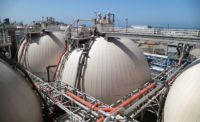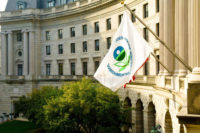The City of Los Angeles’ Hyperion Water Reclamation Plant in Playa del Rey, Calif., spilled 17 million gallons of raw sewage, 6% of its daily load, into the Santa Monica Bay starting July 11 due to a clog of debris–but a timeline shows that health officials failed to inform the public and close contaminated beaches for nearly 18 hours after the incident began.
"We are just getting into the investigation, but we do know that the massive amounts of debris were landscaping and construction materials, as well as grease balls," says Elena Stern, senior public information director at the City of Los Angeles Dept. of Public Works.
The Hyperion plant is operated by Los Angeles Dept. of Sanitation and is Los Angeles County’s largest water treatment facility.
The spill forced closure of at least four miles of county beaches, including those in Dockweiller State Park and in El Segundo, Calif., after the spill started at 7 p.m., and continued through 5 a.m., on July 12, according to Heal the Bay, an environmental nonprofit that advocates for safe and clean coastal waters and watersheds in Greater Los Angeles.
The plant was inundated with overwhelming quantities of debris, causing backup of the headworks facilities, according to Timeyin Dafeta, Hyperion executive plant manager in a statement released July 12.
"The plant's relief system was triggered, and sewage flows were controlled through use of the plant's one-mile outfall and discharge of untreated sewage into Santa Monica Bay,” Dafeta said in the statement.
Treated sewage is normally discharged through a five-mile outfall.
“During the eight hours of discharge through the one-mile outfall, approximately 17 million gallons of sewage (representing 6 % of a daily load) were discharged as an emergency measure to prevent the plant from going completely offline and discharging much more raw sewage,” according to the statement.
The department said protocols for notifying regulatory agencies and California office of emergency services were followed. LA County Dept. of Health says, ultimately, it is elected officials’ responsibility to notify the public of the danger. “Public Health is responsible for determining the need for and making the initial notification to the public, often with support from other entities,” said the public health department in an email to ENR. “This typically occurs within two hours of the determination that an incident has occurred which requires a beach closure.”
A July 12, 2:25 p.m., tweet by Los Angeles County Supervisor Janice Hahn was the first public disclosure of the incident.
The Tweet says, in part, “A power outage at the Hyperion plant last night caused untreated sewage to be discharged into the ocean.” The sanitation department would not clarify if a power outage contributed to the incident.
“We need answers from LA City Sanitation about what went wrong and led to this massive spill, but we also need to recognize that LA County Public Health did not effectively communicate with the public and could have put swimmers in danger,” says Hahn.
Beaches in the Los Angeles area are owned and operated by Los Angeles County and maintained by the county’s Dept. of Beaches and Harbors. Its crews first noticed drainage coming from a small pipe in the median of the Imperial Highway entrance to Dockweiler State Beach parking lot on July 11 (the drainage did not flow into the sand), says Beaches and Harbors Public Information Officer Nicole Mooradian.
Beaches and Harbors contacted contractor Ocean Blue, a hazardous waste management service company, which arrived at 9 p.m. and used three large vacuum vehicles to pump 100% of the drainage into a city approved line. That evening, Beaches and Harbors learned the drainage stemmed from a larger issue at the Hyperion Plant.
“To my knowledge, we were not informed of the size of the spill until the next day,” says Mooradian. “This drainage was our first indication that Hyperion was having issues with its pumps.”
Drew Boyles, mayor of the City of El Segundo, where the beach is closed due to contamination, says he first learned of the incident and beach closures from Hahn and wants to know the exact cause of the outflow.
“How will this be avoided in the future?” asks Boyles. “What reassurances will you provide LA County visitors and residents that your process and outflow is safe and sanitary?”
Hyperion says water quality sampling and testing of shoreline samples are being conducted, and boats are being sent to outfalls to observe and sample for analyses following regulatory permit protocols. Dafeta noted that all flow is again being treated through standard treatment processes. “We are investigating the cause of the debris and repairing damaged equipment,” he said.
Timeline
- On Sunday, July 11, at 7:59 p.m., Hyperion staff sent a spill report to the California State Warning Center, according to Ellie Mirmazaheri, public information officer for the California Governor’s Office of Emergency Services
- On Sunday, July 11, at 8:11 p.m., Cal OES notified via email the Los Angeles County’s public health department that a sewage incident occurred at Hyperion. At that time, Cal OES also notified: Los Angeles County Certified Unified Program Agency (CUPA), Long Beach Environmental Health, LA County Sheriff Dept., LA County Environmental Health, LA County Fire Dept., LA County Dept. of Public Works, California Dept. of Toxic Substance Control, Regional Water Quality Control Board, US EPA, US Fish & Wildlife Service, California Dept. of Fish & Wildlife, California Coastal Commission, California State Lands Commission, California Department of Parks & Recreations, US Coast Guard.
- At approximately 9 p.m. on Sunday, Beaches and Harbors contractor Ocean Blue, a hazardous waste management service company, which arrived at Dockweiller State Park after crews noticed drainage coming from a small pipe. The contractor used three large vacuum vehicles to pump 100% of the drainage into a city approved line. That evening, Beaches and Harbors learned the drainage stemmed from a larger issue at the Hyperion Plant.
- At 10:36 p.m. on Sunday, public health inspectors arrived onsite to determine the extent of the sewage discharge.
- At 12:58 a.m. on Monday, Hyperion officials were still unable to determine how much sewage was discharged through the one-mile outlet.
- At 10 a.m. Monday, Hyperion officials confirmed to the health department that the plant discharged 17 million gallons of untreated sewage through their one and five-mile outlets, prompting the beach closures.
- At 11 a.m. Monday, the health department began posting signs at closed beaches, “since there was an inspector already collecting water samples as part of the routine water sampling process and initiated the website posting identifying the closing of the four of the beaches in the vicinity of the outlets until the ocean water testing meets State standards for acceptable water quality.”
- At 2:25 p.m. on Monday, Los Angeles County Supervisor Janice Hahn sent a Tweet that was the first public disclosure of the incident.
- At 5:15 p.m. Monday, the health department issued a press release.
The health department cites its 2014 standard operating procedures and sewage spill flow that public notification includes, posting closure signs at the affected beaches, updating the websites, notifying lifeguards, and providing information on the Environmental Health telephone hotline.
“We are evaluating our response to this incident and will update our practices going forward to ensure that measures are in place to effectively notify the public,” the health department tells ENR.
This article was updated with information about the timeline of events on July 14, at 5:40 p.m.





